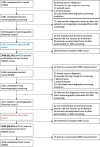Re-attendance in supplemental breast MRI screening rounds of the DENSE trial for women with extremely dense breasts
- PMID: 38639912
- PMCID: PMC11399182
- DOI: 10.1007/s00330-024-10685-9
Re-attendance in supplemental breast MRI screening rounds of the DENSE trial for women with extremely dense breasts
Abstract
Objectives: Supplemental MRI screening improves early breast cancer detection and reduces interval cancers in women with extremely dense breasts in a cost-effective way. Recently, the European Society of Breast Imaging recommended offering MRI screening to women with extremely dense breasts, but the debate on whether to implement it in breast cancer screening programs is ongoing. Insight into the participant experience and willingness to re-attend is important for this discussion.
Methods: We calculated the re-attendance rates of the second and third MRI screening rounds of the DENSE trial. Moreover, we calculated age-adjusted odds ratios (ORs) to study the association between characteristics and re-attendance. Women who discontinued MRI screening were asked to provide one or more reasons for this.
Results: The re-attendance rates were 81.3% (3458/4252) and 85.2% (2693/3160) in the second and third MRI screening round, respectively. A high age (> 65 years), a very low BMI, lower education, not being employed, smoking, and no alcohol consumption were correlated with lower re-attendance rates. Moderate or high levels of pain, discomfort, or anxiety experienced during the previous MRI screening round were correlated with lower re-attendance rates. Finally, a plurality of women mentioned an examination-related inconvenience as a reason to discontinue screening (39.1% and 34.8% in the second and third screening round, respectively).
Conclusions: The willingness of women with dense breasts to re-attend an ongoing MRI screening study is high. However, emphasis should be placed on improving the MRI experience to increase the re-attendance rate if widespread supplemental MRI screening is implemented.
Clinical relevance statement: For many women, MRI is an acceptable screening method, as re-attendance rates were high - even for screening in a clinical trial setting. To further enhance the (re-)attendance rate, one possible approach could be improving the overall MRI experience.
Key points: • The willingness to re-attend in an ongoing MRI screening study is high. • Pain, discomfort, and anxiety in the previous MRI screening round were related to lower re-attendance rates. • Emphasis should be placed on improving MRI experience to increase the re-attendance rate in supplemental MRI screening.
Keywords: Breast density; Breast neoplasms; Early detection of cancer; Magnetic resonance imaging; Patient participation.
© 2024. The Author(s).
Conflict of interest statement
The authors of this manuscript declare relationships with the following companies: Siemens Healthineers (R.M.), Koning (R.M.), PA imaging (R.M.), Screenpoint medical (R.M., N.K.), BD (R.M.), Micrima (R.M.), Volpara Health Care ltd (R.M.), QView Medical Inc (N.K.), Samantree (P.v.D), Sectra (P.v.D.), Visiopharm (P.v.D.), Paige (P.v.D). R.M. is a member of the
Figures
Comment in
-
Why don't all women with extremely dense breasts want MRI screening?Eur Radiol. 2024 Oct;34(10):6332-6333. doi: 10.1007/s00330-024-10773-w. Epub 2024 May 3. Eur Radiol. 2024. PMID: 38700696 No abstract available.
References
Publication types
MeSH terms
Grants and funding
LinkOut - more resources
Full Text Sources
Medical


